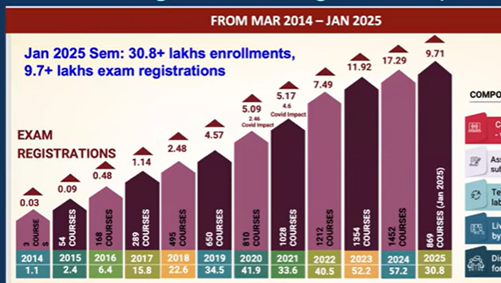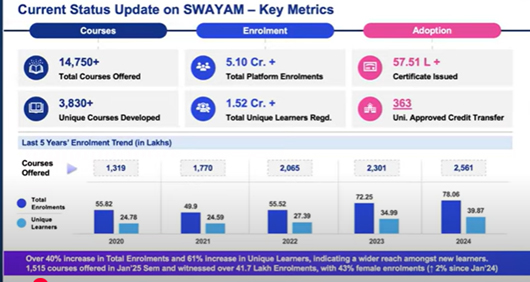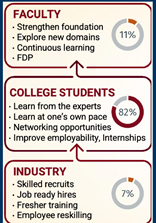About Dr. Mangala Sunder Krishnan
Dr. Mangala Sunder Krishnan is Professor Emeritus in the Department of Chemistry in IIT Madras. Earlier, he was a faculty member (1996-2022) and the Head of the Department of Chemistry at IIT Madras ( 2018- 2021). Prof Krishnan obtained his Ph. D. Degree in 1988 from McGill University, Montreal, Canada in Theoretical Chemistry. He spent several years doing post-doctoral work in major universities in Canada.
Prof Krishnan has guided seven Ph. D. graduates, two M. Tech. students and more than two dozen M. Sc. students in Theoretical Chemistry. He has published his research in international journals in several areas like nuclear magnetic resonance, molecular spectroscopy, and computational chemistry. Currently he has two Ph.D. students associated with him.
Prof Krishnan’s other major interest is Technology Enhanced Learning (TEL). He was the first national web courses coordinator for the National Programme on Technology Enhanced Learning, (NPTEL) (2003-2015) and continues to contribute to this initiative. He was a member of the Standing Committee and Domain Experts Committee of the National Mission on Education through Information and Communication Technology (2009-2017). He was also the first Chief Coordinator for DTH SWAYAM PRABHA for Education through Direct-To-Home Television (2016-2022). He has served as a member on the Boards of NIOS, NCERT and has been a reviewer for the projects on e-learning in the Ministry of IT for more than a decade.
Dr. Krishnan was a member of the Governing Board of India’s leading Sector Skill Council known as NASSCOM IT – ITeS for two terms. He initiated with the advice of NASSCOM, the Digital Skills Academy which helps college students in skills up-gradation and campus placements. He is also a member of the Empowered National Committee on MOOCs and SWAYAM and assists the Ministry of Education in the establishment of online, certified learning processes.
Dr. Krishnan is a University Gold Medallist in both B. Sc. and M.Sc. In addition, he is the recipient of the best graduate student-teacher (Sterry Hunt) award given by McGill University for three years in succession:1984, 1985, 1986. He was also honoured with the President of India Citation for being a pioneering contributor to digital learning in July 2017.
About NPTEL
The National Programme on Technology Enhanced Learning (NPTEL) is the largest e-repository in the world of courses in engineering, basic sciences and selected humanities and management subjects. The platform and content have been developed by the IITs and IISc. Funded by the central government, NPTEL aims to put recorded lectures taught by its member institutes online for open access. Its YouTube channel covers engineering, basic sciences, and some humanities and social science subjects. Popular NPTEL courses are being translated into popular local languages.
NPTEL has adopted the MOOC model so that students outside the IIT system can also access quality content and get certified, provided they meet the assessment criteria in the exams conducted. All courses are free. The certification exam is optional and comes at a fee of Rs 1000 per course exam. Course credits can also be transferred to other higher education institutions under the UGC guidelines.
NPTEL courses aim for equitable access. Students in non-urban and rural areas can also study via supplementary DVDs and mobile delivered content. NPTEL exams can be written by students no matter where they are located. Assessments take place either at an exam site, or via remote proctoring. Plagiarism Detection Software, known as ShodhShuddhi, assists Universities/Institutions with addressing academic integrity matters.
Genesis of NPTEL
As part of an Initiative for implementing Technology Enhanced Learning (TEL) in India, the Ministry of Human Resource Development sent a delegation of Indian educators to the US in 1998. A Workshop on TEL was held in 1999 in, IIT Madras. Faculty from the IITs and IIMs, Carnegie Mellon University, IT experts from industry and the State and Central Governments took part in the deliberations. A Virtual Center for TEL (VCTEL) was set up comprising the five IITs, four IIMs and Carnegie Mellon. Then came the project proposal for the National Programme on TEL, later known as NPTEL in 1999. Prof Paul Goodman of CMU played an important role in the early days of NPTEL. Prof Ananth, Dean IIT Madras also played a pivotal role in getting NPTEL up and running.

Challenges in building NPTEL
Various challenges had to be addressed while building NPTEL.
- Differences in curricula across the 1200 + universities.
- Differences in preparation levels across the 30 + State Boards.
- Differences in cognitive ability and communication skills, particularly English proficiency across students.
- Differences in styles of teaching across instructors.
- Impact of the Internet and social media and now AI.
- Creation of content for different subjects in different formats: Video, Text, Audio, Presentation. Each subject has its own unique flavour.
- Low bandwidth in some parts of the country.
- Copyright / IPR: The project is completely funded by the government. Who owns the copyright for all the contents posted in the portal? The answer is everyone! But everyone must follow the ethical and fair use guidelines. NPTEL uses creative commons.
- Online learning is a supplement to one’s own academic program. How big should the supplement be? It cannot substitute classes on the campus.
- Course completion: World over, self-directed online learning, free or paid, has poor completion rates. Consider IGNOU in India. In 2021-2022, the number of admitted students was > 16,60,000 but only between 2,22,000 and 2,23,000 graduated. Peter Norvig and Sebastian Thurn’s famous course, Introduction to Artificial Intelligence, registered 160,000 students but only 20,000 completed.
Note: The First MOOC was launched by Stephen Downes and George Siemens on Connectivism and Connectivity Knowledge in 2008. About 2500 students enrolled. The completion rates are unknown.

Currently, there are over 3200 courses and 76,240 hours of video content on NPTEL. The portal has 5.3 million+ YouTube subscribers and gets 1.86 billion + views. The following diagram gives the current status for Swayam.

Objectives of NPTEL
Prof Krishnan explained the objectives of NPTEL:
- Higher education, learning and higher order skills with applications
- Higher order skills and learning aligned to national goals
- Higher order skills to help industry and technology for the development and advance the society to the future
- Higher order learning to induce research and innovation spirit among learners and create self-employment opportunities
- Higher order skills to provide lifelong and effective distance learning for continuous self-development
On the need for more capacity
According to the JoSAA 2024 seat matrix, 17740 seats are available in the IITs, 24229 in the NITs and 8546 in the IIITs. These are very small numbers compared to the demand. India has a student population of 26.52 crores in school, 4.33 crores in higher education and more than 11 crores in skilling institutions.
Prof Krishnan emphasised that the number of quality educational institutions must increase by at least two orders of magnitude. There is also a severe shortage of good teachers. With so few seats available in the campuses and a severe shortage of good teachers, there is no other alternative but to expand online learning.
UGC recommends that institutions must permit students to complete up to 40% of their coursework through online classes. (Prof Krishnan feels this is on the higher side.) AICTE recommends a similar percentage. However, for credit transfer, the course pedagogy and content should match to the extent of at least 80% of the host institution’s curriculum.
Other initiatives
Many other activities which help SWAYAM extend the online domain:
- Regional language translation
- Text transcription of videos and PDF of spoken text
- Student scholarships from examination fees that are pooled as corpus
- Student internships and Summer visiting fellowships
- Industry oriented certification
- AI / ML / Data Science / Finance / accounting / skills — new Courses
- Online classes along with orientation to help advanced certification examinations like GATE and UGC Net
- Credits for IIT students to take a certain minimum number of NPTEL courses
- Expanding Institution partnerships and faculty invitations (more than 100 today compared to eight in 2003)

Q&A
Prof Krishnan began as a chemistry teacher. His deep interest in chemistry continues. Now that he is retired, he is free to pursue the problems and research areas that are of interest to him.
However, Prof Krishnan is equally excited and nostalgic about his association with NPTEL. He recalls how he started using technology several years ago, to develop content in physical chemistry. This got a warm reception in IIT Madras. That probably motivated him to look at technology enhanced learning more seriously.
The NPTEL experience has taught him the value of technology enhanced learning and how it can transform the higher education landscape in the country. Prof Krishnan feels that he has been the single biggest beneficiary of NPTEL.
Several impact studies have been done and the findings published on the website. College level SPOCs meet a few times every year to discuss how the courses have impacted their respective colleges.
We must remember that NPTEL is a purely voluntary effort. A large number of courses are available. It is far beyond the ability of an individual student to consume everything. Even then the course completion rate is a creditable 20%. Of course, one of the main motivations for course completion is credit transfer.
There are reports that the students who have done NPTEL courses have benefited in their campus placements. Including NPTEL certification on the resume seems to help during campus placements.
Also, NPTEL has motivated teachers to revamp their teaching methods. Chalk and talk will not go away. The personal element continues to be important. But NPTEL is giving teachers new ideas on how to leverage technology.
This cannot be completely avoided. There is a minimum registration for each course. Otherwise, the course is dropped. But new versions of the course are often floated by other faculty, though their title may be different. For courses which are dropped from NPTEL, the study material is provided, and the colleges can conduct their own exams and give credits. This ensures that students who register for the course are not at a disadvantage.
Free education is not appreciated by many students. But there is merit in offering the content free in a poor country like India, where equity is a major challenge. Charging fees is also tricky in the sense it would depend on the value. And the value of a course is not easy to determine. For additional services such as certification, we can always charge the students.
Many students register with IGNOU and pay the fees. But they do not complete the course. So, charging fees does not guarantee course completion.
China implements initiatives efficiently and at scale thanks to its authoritarian government which provides a unilateral direction. India is a democratic country with a lot of heterogeneity. There is a need to take different stakeholders along. Different state boards have their own views. We can learn some lessons from China, but we cannot replicate the Chinese model wholesale in our country. The focus should not be on numbers alone but also on giving students what they want in terms of high-quality content and pedagogy.
The main collaborators for NPTEL have been the IITs and IIMs. In the early days of NPTEL, discussions among faculty members would sometimes be animated and acrimonious. Different IITs would claim they were experts and ask they be allowed to launch the course. But over time, collaboration has enabled the different professors in the different IITs to come together.
Initially, IIT professors were sceptical about the contributions of non IIT professors. Today, anyone can contribute to NPTEL. The first step is to register our profile. We should check what courses are available and be clear about how the course we want to launch is different from the existing courses. Once we are ready, we can upload the video content. It helps if the director of the institute writes to NPTEL and the Ministry that faculty members are keen to contribute.
In the early days, not much time was spent on this issue. The focus was on launching courses. Now there is a lot of promotion for NPTEL on social media. But obviously, education is not the hottest topic for the media which likes to focus on more sensational stuff. So more than media coverage, word of mouth will continue to play an important role.
There is no upper age limit to do the NPTEL courses. There is only a lower age limit to ensure that students have the required maturity to pursue the course.
Universities must decide how they must train their faculty. One way for the faculty to upgrade their knowledge and skills is to stay in touch with the industry is to work as consultants. But the government cannot play a direct role here.
To become consultants, the faculty must demonstrate they can provide value to industry. Industry emphasises focused initiatives with clearly defined outcomes/timelines and returns for the money invested. Often industry does not find value in employing faculty for consultancy work.
Faculty must also not complain about shortage of time. They must seize the initiative and go beyond their regular working hours, when they are expected to work for their institutions.
One way to get started is by interacting with local industries. Faculty can offer services to them, maybe free, to start with.
Though some good private schools do pay their teachers well, many do not. The owners treat education as a business. This is a serious matter and must be taken up with the local government/ education boards. The situation in government schools seems to be somewhat better. The compensation norms are clearly defined.
